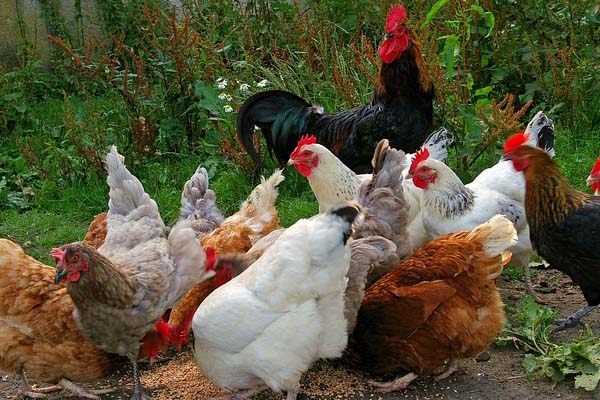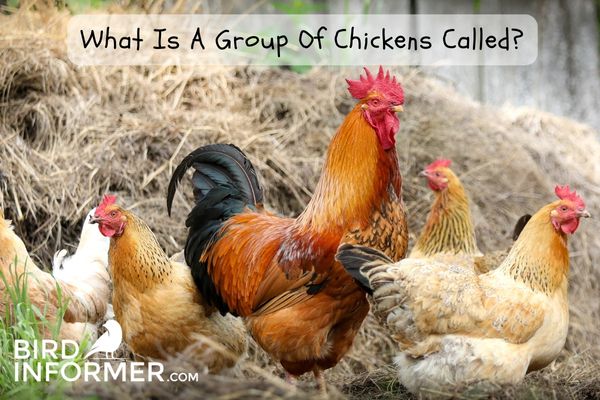Contents
- Additional Names for a Group of Chickens
- Important Chicken Terms and Their Meanings
- A Breakdown of Chickens Societies
- What Does This Social Hierarchy Determine?
- What Happens When a Rooster or Cockerel Is a Member of the Flock?
- What Happens When Outsiders Try to Merge with a Flock?
- How Do Chickens Determine When It’s Time to Gather or Flock Together?
- What Is the Typical Size of a Flock of Chickens?
- Chicken Families: Do They Remain Together In Broods?
Many of us wonder about the actual name of a group of chickens. Is it called a murder of chickens, just like there’s a murder of crows? Or is it something else entirely? Keep reading to find out the name of their group and more.
Most commonly, the collective name for a group of chickens is typically called a flock of chickens. Other names include peep of chickens or brood of chickens. The name flock is most commonly used to identify different groups of numerous birds. A brood signifies the name of a chicken’s family unit.
Here’s the situation:
You wouldn’t be here if you didn’t want to know the true name of a group of chickens. But I’m sure there are other name-related questions running through your mind. I’ll do my best to answer questions on a number of related topics. They include:
- Additional names for a group of chickens
- Do chickens stay together in flocks?
- The reasons chickens flock together
- When chickens decide to gather together
- and other related info
To learn lots more about chicken groups, reasons for flocking together, and other valuable related topics, please continue reading below.
Additional Names for a Group of Chickens
Besides flock, peep, and brood, a group of chickens goes by additional names. These names are fairly self-explanatory, so I’ll share them with you now, and you’ll easily understand their meaning. They include:
- Clutch of chickens
- Collection of chickens
- Flight of wild chickens
- Run of chickens
- Brood of chickens
- Flock of chickens
- Peep of chickens
For the most part, it’s pretty easy to figure out the meanings of these names. If you’re wondering about a run of chickens, this name most likely refers to chickens when they are spending time in a chicken run. This enclosure remains attached to the side of the chicken coop, and it’s where the famous movie Chicken Run got its name.
Do You Know What To Call A Group Of Turkeys?
See if you’re right by clicking the button below!
Do Chickens Stay Together in Flocks?
To no one’s immediate surprise, yes, chickens will stay together in flocks while laying eggs and raising chickens. Or, if you prefer, you can call them groups of chickens, peeps of chickens, or if it’s a family, it’s considered a chicken brood.
According to Birdfact.com,
Chickens are sociable and gregarious birds and prefer to live in groups of some three or more hens, with one cockerel for every 5 to 15 or so hands if the owner wishes for them to reproduce.
Like many other creatures, including human beings, chickens will become depressed and anxious when left alone or only in the company of one other chicken. Domesticated chickens tend to breed together communally. This means the hands will rear young chickens together and also share sitting on each other’s eggs.
Feral chickens exist in the wild, although the majority of them are domesticated at this point. Usually, these feral chickens have escaped from their domesticated confines and now live together with several birds in each flock.
The Reasons Chickens Flock Together

Determining why chickens like to flock together isn’t the easiest task to accomplish. The plight of the chicken has irrevocably been shaped by breeding programs created by humans. Because of this, their flocking-related behaviors have undoubtedly evolved along with their domestication.
Here’s what we know for sure:
The bulk of their gregarious and social behavior exists as part of their reproduction process. Mel cockerels, for example, maintain the breeding rate of female chickens. Ultimately, their overall goal is to produce additional offspring.
When chickens flock together systematically, their overall hierarchy tends to exist with strong reproductive tendencies. This allows chickens to innately maintain high birth rates.
Chickens also have a difficult time surviving in cold weather, which is very common amongst many animal species throughout the world. By flocking together in groups, these chickens can survive and outlive cold weather spells by huddling together to maintain warmth.
Do you know another reason why chickens flock together? It’s an additional tool for survival for chickens living out in the wild. They are driven by their social instincts, so working together in a group helps them to survive and thrive when danger from humans, other animals, or natural elements rears its ugly head.
Important Chicken Terms and Their Meanings
| A female chicken over 1-year-old that has reached maturity | Meaning |
|---|---|
| Bantam | This specifically refers to small chicken breeds |
| Chook | An informal name for a chicken |
| Cock | The name for a male chicken younger than 1-year-old |
| Cockerel | Young male or female chickens are classified as juveniles |
| Hen | This is a shortened name for cockerel. It’s the name of a male chicken younger than 1-year-old |
| Hybrid | A non-purebred chicken made up of two different breeds |
| Juvenile | A term to describe domestic livestock birds, including ducks, geese, chickens, and turkeys |
| Layer Breed | A chicken breed raised specifically for egg production |
| Poultry | A male chicken over 1-year-old that has reached maturity |
| Pullet | The name of a young female chicken below 1 year of age |
| Rooster | The name of a young female chicken below one year of age |
A Breakdown of Chickens Societies
Chickens form and maintain strong bonds with each other from a social standpoint. But their system isn’t completely equitable or fair.
As an example, a pecking order will form amongst a flock of hens if no rooster is present. The dominant hand remains at the top of the food chain, so to speak. Other less dominant chickens will drop several tears lower and remain at the bottom of the food chain.
What Does This Social Hierarchy Determine?
For starters, it helps to decide which chickens get to feed first in the pecking order. It also allows the group to determine which chickens get to choose the best nesting areas with access to dust baths and drinking facilities.
Hen hierarchies never necessarily result in aggravation or bullying towards the lesser chickens in the hierarchy. In fact, it’s typically the opposite which seems counterintuitive. These two hens or more tend to form strong and lasting bonds of friendship with one another.
What Happens When a Rooster or Cockerel Is a Member of the Flock?

In the situation where a male rooster is a member of the flock, he mates with all of the hands, which typically amounts to 10-15 of them. These hens are subordinate to the dominant cockerel or rooster member of the flock.
When more than one male is a member of a particular flock, the males get to pick and choose which hens they prefer to mate with. This isn’t a one-way street, though. In the case of multiple males, the hens also get to choose the rooster they prefer to mate with too.
What Happens When Outsiders Try to Merge with a Flock?
If an outsider attempts to merge with the flock, it doesn’t usually go over very well with the original members of the group. They will often attack or bully the new member attempting to merge with them.
Overall, it seems like they will lead the new chicken merge with the peep, but it doesn’t appear to be a very friendly or welcoming experience for the new member of the tribe.
How Do Chickens Determine When It’s Time to Gather or Flock Together?
There are many different ways to determine what a group of chickens is based on different scales. As an example, if you were to look at a group of chickens that number in the thousands on a commercial farm, would you call them a flock? More than likely, you wouldn’t consider it a flock of chickens because they are herded together by the farmer and aren’t sticking together due to gregarious or social natural instincts.
Out in the wild, feral chickens have learned to gather together in flocks once again. They needed to reestablish themselves and their natural instincts to create pecking orders, social hierarchies, and groups in the form of a flock.
In small commercial ventures, the chickens within these commercial establishments will develop social flocks as long as there are enough birds to accomplish the task. When their natural environment permits it, chickens will instinctively come together and form flocks because they prefer living as a group.
What Is the Typical Size of a Flock of Chickens?
- The smallest peep of chickens will maintain at least three birds
- The typical size of a small chicken flock consists of 6-10 birds
- The normal size of an average chicken flock is made up of 10-15 birds
- A large flock of chickens on a poultry farm could be made up of thousands of them, but they aren’t typically looked upon as a brood or flock
Chicken Families: Do They Remain Together In Broods?
Many of us wonder whether or not chicken families, better known as chicken broods, stay together.
Do the baby chicks form bonds with their mother, a mature female chicken?
According to Backyardpoultry.com,
As they learn about their mother, an emotional bond grows between them so that they become inseparable for the first six weeks of the chicks’ lives. After the first day, they also bond with their siblings.
Backyard Poultry
Chicken broods consisting of small to medium sizes generally stay together and form social bonds that grow very strong. During the night, chickens will share warmth and roost together when necessary.
When chickens are being reared, like a young hen or male chickens, the hens of a particular chicken brood will share incubating duties, rearing duties, and brooding duties.
As long as feral or backyard chickens are socialized and raised together, they will maintain a specific social hierarchy that won’t aggravate or harm the group. The only exception to this rule is when two or more broods or flocks are brought together. Things can get very edgy in this situation.
For the most part, baby chickens will get very close to their mothers, as quoted above. They will typically stay together for 4-8 weeks. Chickens grow very quickly and tend to reach sexual maturity within 4-6 months. At this stage, they will begin breeding and laying their own eggs.

